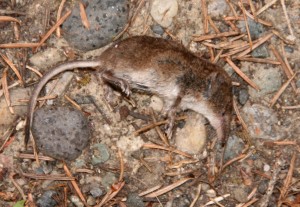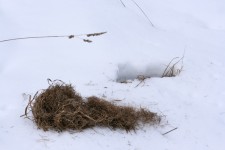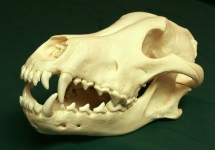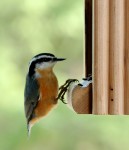Shrews are one of the smallest mammals in North America and the smallest one resides in North Idaho–the pygmy shrew. The pygmy shrew weighs between two and four grams, roughly the weight of a pencil. Other shrews that reside in North Idaho include the American water shrew, masked shrew, montane shrew and vagrant shrew.
Shrews may look like mice but they are significantly different because they belong to a different order containing insectivores and they have pointed noses, small ears and tiny eyes. Like voles, identifying a shrew on the species level is difficult.
One unique aspect of a shrew, if you can catch one or find one dead, is that they all have reddish tips to their teeth. Shrews can also be identified by five toes on all feet whereas mice have four toes on the front feet and five toes on the hind feet.
All insectivores use senses besides sight to find food, mainly hearing, touch and smell. Shrews have many characteristics that allow them to forage for insects.
Shrews have tiny eyes because they don’t rely on sight to find their food. Their pointed snout helps them burrow through soil to reach grubs including earthworms, insects, spiders and other small animals such as young mice, salamanders, snails and slugs. Some shrews even use echolocation like bats to find insects.
Since their sense of smell is extremely important for finding food, a larger portion of their brain is devoted to their sense of smell. Once shrews find an insect, they catch the insect with their two enlarged, pincer-like upper front incisors that protrude forward.
As big eaters, shrews eat at least their body weight in food each day. If they don’t eat frequently they may die of starvation so shrews store food in their nest. This voracious appetite doesn’t keep shrews from being picky eaters. Shrews prefer fresh food, even fresh stored food.
With a diet of insects, storing fresh food may seem unlikely but shrews keep their catch fresh by crushing the prey’s skull and biting off the legs. This keeps the insect alive until the shrew eats it. Shrews have sharp, pointed teeth adapted just for crunching on insect exoskeletons.
While shrews may have a voracious appetite and a unique way of storing food, they are not on the top of many predators food list. Many shrews emit a musky odor from scent glands that resembles a skunk odor and effectively deters most predators except for owls.
Like some mice, voles and lemmings, shrews are mainly nocturnal but will also be sporadically active during the day. They burrow in the leaf litter or humus layer to travel or travel in the burrows or runways made by voles and moles (also an insectivore).
Like the water vole, the water shrew readily takes to water and lives around streams and ponds. The water shrew can even run on water because of the long, stiff hairs between its toes and along the sides of feet that trap air bubbles.
Many of the shrews, mice, voles and lemmings survive the cold winter temperatures by living in the subnivian zone. This zone stays within one to two degrees of freezing regardless of the air temperature if there is adequate snow cover.
Occasionally, tracks of these small mammals can be seen on the surface of the snow scurrying between trees or clumps of grass. However, the small mammals don’t stay on the surface long because they are more prone to predation, even if they possess a musky odor.






Mice and shrew are the same but different looks